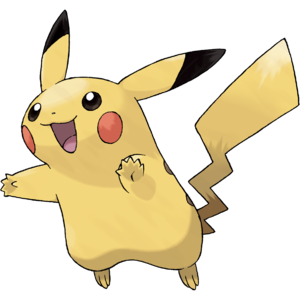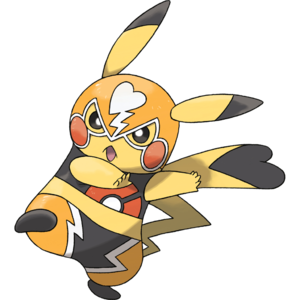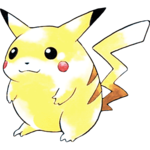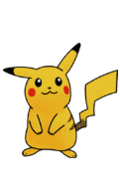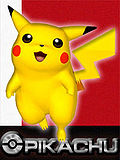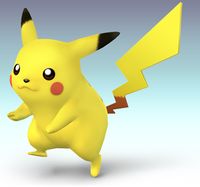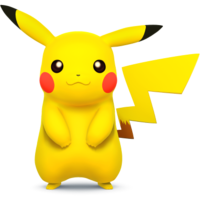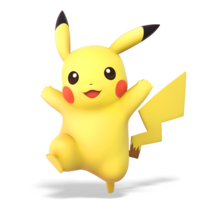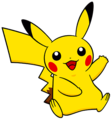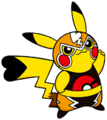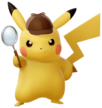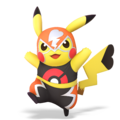Pikachu
- For fighter info, see Pikachu (SSB), Pikachu (SSBM), Pikachu (SSBB), Pikachu (SSB4), and Pikachu (SSBU).
| Pikachu | |
|---|---|
 Official artwork of Pikachu from Pokémon FireRed and LeafGreen Versions and Pikachu Libre from Pokémon Omega Ruby and Alpha Sapphire. | |
| Universe | Pokémon |
| Debut | Pokémon Red and Green Versions (1996) |
| Smash Bros. appearances | SSB Melee Brawl SSB4 Ultimate |
| Most recent non-Smash appearance | Pokémon Legends: Z-A (2025) |
| Species | Pikachu |
| Gender | Varies |
| Place of origin | Kanto |
| Created by | Atsuko Nishida |
| Designed by | Atsuko Nishida Ken Sugimori |
| Voice actor | Ikue Ōtani |
| Article on Bulbapedia | Pikachu (Pokémon) |
Pikachu (ピカチュウ, Pikachu) is a Mouse Pokémon from the Pokémon series. It debuted in the series' first generation, and as a member of the "perfect-attendance crew", Pikachu has been featured as a playable character throughout the entire Super Smash Bros. series. Similarly to Mario and Link, Pikachu is one of the most well-known video game characters in the world, to the point of being the de facto mascot of the Pokémon series.
Origin[edit]
Pikachu is a small, rodent-like Pokémon characterized by its yellow fur, long, conical ears with black tips, thunder bolt-shaped tail, and round, red cheeks. A pure Electric-type Pokémon, it is categorized within the Pokédex at #025 as the "Mouse Pokémon". The extensive variety of Pokédex entries available for Pikachu throughout the Pokémon series provide plenty of biological information about the species: it stores electric energy within its cheeks, and releases this energy when startled or angered. Groups of Pikachu typically live in secluded forests, and can occasionally cause thunderstorms when gathered together. It is the evolved form of Pichu, and evolves into Raichu when exposed to a Thunder Stone, with the latter having an Electric/Psychic-type regional form endemic to Alola.
Pikachu was designed by graphic designer Atsuko Nishida on the impetus of creating more "cute" Pokémon during development; the earliest Pokémon designed were fearsome beasts, such as Rhydon. With this in mind, she originally based the design on daifuku, a Japanese sweet that is often crafted to resemble a rabbit (the basis of its long, rabbit-like ears). The creature's final design, including its ability to store electricity in its cheeks, is largely based upon squirrels, which Nishida had been obsessed with at the time. She coined the name "Pikachu" after the onomatopoeia "pika pika" (the sound of sparking electricity) and "chu chu" (the sound of a mouse's squeak). Lastly, lead artist Ken Sugimori drew the final character artwork based on Nishida's dot sprite.[1]
In the core series, Pikachu is a relatively weak yet somewhat rare Pokémon that can be found early in the series' first generation of games: Pokémon Red, Green and Blue Versions. Unlike certain Pokémon that had plot elements wrapped around them, such as Mewtwo, Pikachu was simply a Pokémon that could be readily caught, evolved into a stronger form, and had no bearing on the story. According to programmer Kōji Nishino, its unusual rarity was because he was personally fond of the design and wanted it to be difficult to find; however, this resulted in Pikachu becoming popular among players precisely due to its rarity.[2]
Soon afterwards, Pikachu's popularity led to its prominent appearance in the Pokémon anime, where a member of the species became the first Pokémon acquired by Ash Ketchum, the anime's main character for the first 25 seasons. This, in turn, resulted in Pikachu becoming the main mascot of the series. To capitalize on its fame, it became a major focus of many Pokémon spin-offs, along with being the version mascot for Pokémon Yellow Version, a remake of Red, Green and Blue Versions that is largely based on the anime. In keeping with the anime, a Pikachu is the first Pokémon that the player obtains, and its digitized cry from the previous versions is replaced with voiced soundbites provided by Ikue Ōtani, Pikachu's voice actress from the anime, who also voices him throughout the Super Smash Bros. series. Ikue Ōtani would also voice Pikachu in the core series Pokémon games from Pokémon X and Y up until Pokémon Brilliant Diamond and Shining Pearl.
Following Yellow Version, Pikachu has since been featured in every core series game, and is usually associated with some new gameplay mechanic with each successive installment. It is also readily available to catch in all games within the core series, with the exception of those in the fifth generation (Pokémon Black and White Versions and Pokémon Black and White Versions 2). In Pokémon Ruby and Sapphire, Pikachu gains the signature move Volt Tackle, which can be learned by breeding a female Pokémon of the Pikachu line while holding the Light Ball introduced in Pokémon Gold and Silver. Volt Tackle became Pikachu's Final Smash beginning with Brawl. Pokémon Diamond and Pearl introduced the concept of gender differences with female Pikachu having a dent at the tip of their tails that makes it look like a heart. The female Pikachu's design is the basis for two of its alternate costumes in Ultimate, one of which includes a Cosplay Pikachu named Pikachu Libre, which was introduced in Pokémon Omega Ruby and Alpha Sapphire and featured in Pokken Tournament.
Pikachu has also been featured in virtually every Pokémon-related spin-off game ever released, sometimes as a main character or merely being featured among the hundreds of other Pokémon species. Notable Pikachu-centric games include Hey You, Pikachu!, where the player can talk to Pikachu using the Voice Recognition Unit; Pokémon Channel, which is usually regarded as a spiritual sequel to Hey You, Pikachu!; and the PokéPark series, which features a Pikachu as the main character. The Pokémon Mystery Dungeon series has also consistently featured Pikachu as one of the Pokémon that the player can start out as.
A more anthropomorphic male Pikachu, capable of speaking human language, appears as the main character in the Detective Pikachu sub-franchise. In the game, he is voiced by Tōru Ōkawa in Japanese, and by Kaiji Tang in English; in the Detective Pikachu film, Ryan Reynolds and Hidetoshi Nishijima provide the character's spoken dialogue in English and Japanese respectively, and Ōtani reprises her role to provide his traditional vocalizations in all languages. The end of the movie explains the origin of Detective Pikachu, relating to his two said voice actors' other character portrayal, Harry Goodman.
Much like its fighting game appearances in the Super Smash Bros. series, Pikachu is one of the playable Pokémon in Pokkén Tournament and its enhanced version. While the initial arcade release features a presumably male Pikachu, the female Pikachu Libre was later introduced as an additional character with a different moveset.
In Super Smash Bros.[edit]
As a playable character[edit]
Pikachu's debut in the Super Smash Bros. series is as one of the eight starter characters. Just like in its home series, Pikachu is a small, fast character whose playstyle is prominently dependent on its speed and powerful electrical attacks. Pikachu's neutral special move, Thunder Jolt, emits a bolt of electricity that bounces along the stage. Quick Attack is Pikachu's up special move and while it's not capable of dealing damage, it has fantastic recovery distance. Lastly, its down special move, Thunder, involves Pikachu striking itself with a thunderbolt that blasts anyone else standing in the way.
Pikachu is considered the best character among the SSB competitive community and is ranked 1st on the tier list, placing it in the S tier.
In-game description:
- Pikachu
- Mouse PKMN
- Height 1'4"
- Weight 13lbs
- When several of these Pokémon gather, their electricity could cause lightning storms.
- (Pokédex excerpt)
- Works:
- Pokémon (GB)
In Super Smash Bros. Melee[edit]
As a playable character[edit]
Pikachu returns as a starter character. While its playstyle is still incredibly similar to its first appearance, Pikachu was nerfed in Melee. Despite this, Pikachu still holds up at 9th out of 26 on the tier list, ranking at C tier. It has gained Skull Bash as a side special move, and possesses a respectable mix of speed and power. Pikachu is the only Pokémon which is available from the start of the game. On the character selection screen, it appears initially after Mario on the top row, but moves to the bottom row when Luigi is unlocked.
Trophies[edit]
In line with the other playable characters, there are three Pikachu trophies obtained by defeating the single-player modes - a normal trophy from Classic Mode, and "Smash Red" and "Smash Blue" trophies from the Adventure and All-Star modes, respectively.
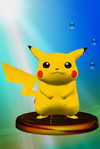
- Pikachu
- It's safe to say that Pikachu is the most famous and popular of all Pokémon. It has electric pouches in both cheeks; when in danger, it shoots electricity at its enemies. Although Pikachu can evolve into Raichu by exposure to a Thunderstone, many trainers like Pikachu so much that they don't let it evolve.
- Pokémon Red & Blue (9/98)
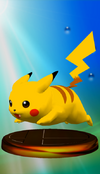
- Pikachu SMASH
- While its electric attacks, such as Thunder and Thunder Jolt, are powerful, Pikachu is at its best speeding around the fray and waiting for its chance to strike. You can control the path of Pikachu's two-directional Quick Attack, allowing you to jump twice. Hold down the B Button to charge up Skull Bash.
- B: Thunder Jolt
- Smash B: Skull Bash
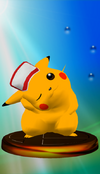
- Pikachu SMASH
- The angle of the Control Stick controls the direction of Pikachu's Quick Attack. Pikachu will move blindingly fast, and it will also cause damage to any character it runs into. Move the Control Stick during the Quick Attack and Pikachu will move in up to two directions. Be sure to check out the ceilings on the level when you use Thunder.
- Up & B: Quick Attack
- Down & B: Thunder
In Super Smash Bros. Brawl[edit]
As a playable character[edit]
Pikachu returns as a starter character in Brawl. Visually, Pikachu has barely changed at all from its Melee design, only being touched up slightly. While its position on the tier list isn't much of an improvement from Melee, Pikachu is considered to have been buffed in Brawl, becoming more powerful and gaining many new techniques such as Quick Attack canceling and two chain grabs in exchange for mainly weaker knockback in its attacks. Pikachu is ranked 8th on the tier list, placing it in the B tier. Like the rest of Brawl's cast, Pikachu possesses a Final Smash, a new kind of special attack that debuted in Brawl. In Pikachu's case, its Final Smash is its signature move in the Pokémon series, Volt Tackle, which involves it generating a giant ball of electricity around itself that can be controlled by the player in order to slam into and/or shock the opponent.
Trophy[edit]
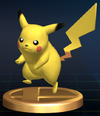
- Pikachu
- A Mouse Pokémon. Its lightning-bolt tail and round cheeks are its trademarks. When danger draws near, it uses tiny electric pouches within its cheeks to discharge electricity. When it's really fired up, it unleashes electricity on its rivals. It's said to recharge when it's sleeping. It evolves into Raichu.
: Pokémon Red/Blue
: Pokémon Diamond/Pearl
Sticker[edit]
| Name | Game | Effect | Fighter(s) |
|---|---|---|---|
| Pikachu | Pokémon series |
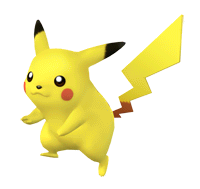 Pikachu (Pokémon series) |
In Super Smash Bros. 4[edit]
As a playable character[edit]
Pikachu returns as a starter character, with its design having been updated to appear in line with its more recent appearances in the Pokémon series, namely being slimmed down somewhat.
Pikachu is ranked 15th on the SSB4 tier list. Pikachu received some nerfs in the transition from Brawl, such as its powerful down throw and forward throw chain grabs (which were a large part of Pikachu's prior success in Brawl) being removed, and lower damage outputs on some moves. In return, Pikachu benefits from the changes to hitstun canceling, which improve its combo game by enabling its attacks to chain together easier. Some of its attacks' ranges and their KO potential were also improved. However, Pikachu suffers from poor endurance, and has a general lack of reliable KO options. Despite having a small playerbase in the competitive scene, Pikachu still gained a bit of success in the Smash 4 metagame from a few players.
Trophies[edit]
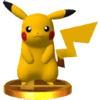
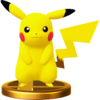
- Pikachu
Recognized the world over, Pikachu is an Electric-type Pokémon that stores energy in its cheeks for use in battle. In Smash Bros., Pikachu is a well-rounded fighter with speedy, powerful electric attacks. Quick Attack can be used twice in a row if two directions are input, one after another.
: Pokémon Red & Pokémon Blue (09/1998)
: Pokémon Yellow: Special Pikachu Edition (10/1999)
Pikachu is famous worldwide as the face of the Pokémon series. There's a lot of electricity stored in those rosy cheeks, and in this game, that allows for some devastating attacks, like Thunder Jolt. Tip: Input another direction after using Quick Attack to get a second burst. It's top-notch for recoveries!
: Pokémon Red/Blue (10/1999)
: Pokémon Yellow (06/2000)
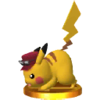
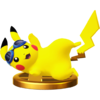
- Pikachu (Alt.)
 Pikachu's Thunder Jolt fires off a ball of electricity that bounces across the stage, getting weaker as it travels. It does more damage to enemies in the air. The default down special, Thunder, causes a lightning strike that both shocks opponents and turns Pikachu invincible for a split second.
Pikachu's Thunder Jolt fires off a ball of electricity that bounces across the stage, getting weaker as it travels. It does more damage to enemies in the air. The default down special, Thunder, causes a lightning strike that both shocks opponents and turns Pikachu invincible for a split second. Pikachu's Thunder Jolt fires off a ball of electricity that bounces across the stage, getting weaker as it travels. It does more damage to enemies in the air. The default down special, Thunder, causes a lightning strike that both shocks opponents and makes Pikachu invincible for a split second.
Pikachu's Thunder Jolt fires off a ball of electricity that bounces across the stage, getting weaker as it travels. It does more damage to enemies in the air. The default down special, Thunder, causes a lightning strike that both shocks opponents and makes Pikachu invincible for a split second.: Pokémon Red & Pokémon Blue (09/1998)
: Pokémon Yellow: Special Pikachu Edition (10/1999)
Pikachu's Thunder Jolt fires off a ball of electricity that bounces across the stage, getting weaker as it travels. Airborne enemies will take extra damage from it and get launched further. The default down special, Thunder, causes a lightning strike that both shocks opponents and turns Pikachu invincible for a split second.
: Pokémon Red/Blue (10/1999)
: Pokémon Yellow (06/2000)
In Super Smash Bros. Ultimate[edit]
As a playable character[edit]
Pikachu returns as a starter character in Super Smash Bros. Ultimate. For the first time in the series, Pikachu now has female variants to choose from via alternate costumes, one of which is Cosplay Pikachu wearing the Pikachu Libre attire.
Pikachu received several changes and buffs in the transition to Ultimate, including a new neutral aerial that acts similarly to Mewtwo's. Due to the significance of its buffs, some players have argued that Pikachu could be one of the best characters in the game. However, its small presence at the top level of competitive play weakened these arguments, and Pikachu was never ranked among the best characters, though it remains ranked amongst the top 20 on the tier list.
Spirits[edit]
Fighter spirits[edit]
Support spirits[edit]
| No. | Image | Name | Class | Cost | Ability | Series |
|---|---|---|---|---|---|---|
| 562 | Detective Pikachu | ★★ | 2 | Fog Immunity | Detective Pikachu | |
| 1,298 | Partner Pikachu | ★★★ | 1 | Undamaged Attack & Speed ↑ | Pokémon Series |
Gallery[edit]
Names in other languages[edit]
Trivia[edit]
- Pikachu and Charizard are the only playable Pokémon that are game mascots.
- Pikachu is the only playable Pokémon in the Super Smash Bros. series to have a visible gender difference. Male Pikachu look like the one in the Super Smash Bros. series, while females have a heart shape at the tip of their tail. However, gender differences in the Pokémon series were introduced in Generation IV, which debuted well after SSB and Melee did. As a result, and because its alternate costumes include hats commonly worn by male characters, the Pikachu in the Super Smash Bros. series is commonly perceived as male. In addition, Ultimate gave it two distinctly female variants via alternate costumes. Even so, Pikachu is not listed under a specific gender, as Nintendo and its affiliates primarily use gender-neutral pronouns for all Pokémon, no matter a species' appearance/gender ratio or lack thereof.
- Pikachu is the only character to have only four alternate costumes in the first three Super Smash Bros. games. It has eight alternate costumes in SSB4, just like every other character aside from Little Mac and the Mii Fighters.
- As of the current tier lists for each installment of Super Smash Bros., Pikachu and Fox McCloud are the only characters who have never been ranked lower than the upper portion of the mid-tier.
- Both characters have incidentally also been at the top of a tier list before.
- Pikachu's poses for its Classic trophy in Melee and its official artwork for SSB4 resemble its sprite from Pokémon Yellow Version.
- Mario and Pikachu are the only members of the "Original 8" to never have been the sole fighters from their respective series.
References[edit]
